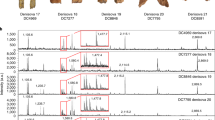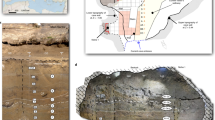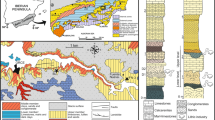Abstract
MUCH evidence suggests that man was present in the Western Hemisphere before 12,000 yr ago, but the case has remained less than conclusive1. In some situations, the geological age of the site is reasonably well established but the association or nature of the artefacts is questionable2,3. In other cases, museum specimens of human bones dated by radiocarbon analysis of collagen lack desirable information concerning site location, geology, and stratigraphy even though the accuracy of their absolute ages seems valid4–6. We report here the results of radiometric dates of the Yuha burial site from Imperial County, California, for which the geology and stratigraphy have been documented and reported in detail7.
This is a preview of subscription content, access via your institution
Access options
Subscribe to this journal
Receive 51 print issues and online access
$199.00 per year
only $3.90 per issue
Buy this article
- Purchase on Springer Link
- Instant access to full article PDF
Prices may be subject to local taxes which are calculated during checkout
Similar content being viewed by others
References
Haynes, C. V. Science, 166, 709–715 (1969).
Leakey, L. S. B., Simpson, R. DeE., and Clements, T., Science, 160, 1022–1033 (1968).
Haynes, C. V., Science, 181, 305–310 (1973).
Berger, R., and Libby, W. F., Radiocarbon, 11, 194–209 (1969).
Berger, R., Protsch, R., Reynolds, R., Rozair, C., and Sackett, J. R., Contr. Univ. Calif. Archaeol. Res. Fac., No. 12, VI, 43–49 (1971).
Protsch, R. J. Hum. Evol., 4, No. 4 297–322 (1975).
Childers, W., Anthropological J. Canada, 12, 2–9 (1974).
Bada, J. L., Schroeder, R. A., and Carter, G. F., Science, 184, 791–793 (1974).
Bender, M. L., Nature, 252, 378–379 (1974).
Bada, J. L., Nature, 252, 379–381 (1974).
Bada, J. L., Earth planet, Sci. Lett., 15, 223–231 (1970).
Bada, J. L., Kvenvolden, K. A., and Peterson, E. Nature, 245, 309–310 (1973).
Bada, J. L., Protsch, R., and Schroeder, R. A., Nature, 241, 394–395 (1973).
Williams, G. E., and Polach, H. A., Bull. geol. Soc. Am., 82, 3069–3085 (1971).
Hart, M. W., Bull geol. Soc. Am., 85, 1329–1332 (1974).
Bowler, J. M., Thorne, A. G., and Polach, H. A., Nature, 240, 48–50 (1972).
Oakley, K. P., Frameworks for Dating Fossil Man, 7 (Weidenfeld and Nicolson. London, 1969).
Author information
Authors and Affiliations
Rights and permissions
About this article
Cite this article
BISCHOFF, J., MERRIAM, R., CHILDERS, W. et al. Antiquity of man in America indicated by radiometric dates on the Yuha burial site. Nature 261, 128–129 (1976). https://doi.org/10.1038/261128a0
Received:
Accepted:
Issue Date:
DOI: https://doi.org/10.1038/261128a0
This article is cited by
-
The archaeology of radiocarbon accelerator dating
Journal of World Prehistory (1987)
-
Holocene age of the Yuha burial: direct radiocarbon determinations by accelerator mass spectrometry
Nature (1984)
Comments
By submitting a comment you agree to abide by our Terms and Community Guidelines. If you find something abusive or that does not comply with our terms or guidelines please flag it as inappropriate.



